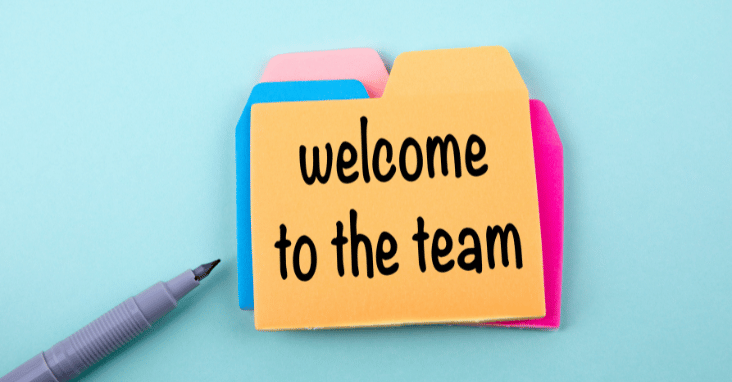Hello there! Have you ever wondered why welcoming a new employee is so crucial in the corporate world? I mean, they’ve got the job, they’re set to start… isn’t that enough? Well, believe it or not, it’s just the beginning of their long and successful journey. When a newbie walks into your company, they’re stepping into a whole new universe. So, as someone who’s already part of that universe, it’s your job to make them feel comfortable and welcome. Let’s talk about why that’s so important and how you can make it happen!
A welcome message is a brief greeting or introduction given to someone upon their arrival at your company. It matters because it sets the tone, creates a positive first impression, and helps the new employee feel acknowledged, valued, and familiar with the environment they are entering.
Why Does a Welcome Message Matter?
First impressions count, right? You know that feeling when you walk into a party, and someone you’ve never met comes up to you with a wide smile and introduces themselves? It feels pretty good, doesn’t it? You immediately feel a little bit more at ease, a bit more welcome.
Well, the same goes for the workplace. When you welcome aboard a new employee with a warm and personalized message, you’re giving them that same comfortable feeling. You’re telling them, “Hey, we’re glad you’re here, and we can’t wait to see what you bring to our team.” That can do wonders for an employee’s motivation and job satisfaction from day one.
But it’s not just about the immediate impact. A warm welcome can also have long-lasting benefits for your company culture. It can foster a sense of belonging and camaraderie among your team. It can set the tone for open and honest communication. It can even boost productivity and retention in the long run. And the research backs it up – companies with strong onboarding processes can improve new employee engagement and hire retention by 82% and productivity by over 70%.
Key Takeaways:
Welcoming a new employee is about more than just a friendly hello; it’s about making them feel comfortable, valued, and excited to be part of your team.
A warm welcome can have immediate and long-term benefits, both for the employee and for your company culture.
With a well-crafted welcome message, you can foster a sense of belonging, encourage open communication, and even boost productivity and retention.

Key Elements of a Warm Welcome Message
So, you’re probably thinking, “Great, I’m sold on the warmest welcome message idea. But how do I actually craft one that hits all these high notes?” Don’t worry, I’ve got your back. Here’s a simple guide to the must-have ingredients for a warm and effective welcome message.
The Personal Touch
First things first, keep it personal. Don’t you just love it when someone remembers your name? It’s a small thing, but it can make a big difference. So, use your new employee’s name in your welcome message. It shows that you see them as an individual, not just a new addition to the workforce.
And don’t forget to acknowledge their role! Mentioning the new position that they’ve been hired for will make them feel recognized and important. It’s like saying, “We hired you for a reason, and we can’t wait to see you shine in your role.”
Show Genuine Enthusiasm
Next up, let your excitement shine through! This isn’t the time to play it cool. A bit of enthusiasm can be infectious, and it can help your new hire feel even more excited about starting their new job. So, don’t be shy about expressing how thrilled you are to have them on board.
An Introduction to the Tribe
Then, take a moment to introduce the next team member, or the company. This can be as simple as sharing your company’s mission and values, or it could involve introducing key team members. Remember, this is their first glimpse into their new work family, so make it count!
Crystal Clear Next Steps
Finally, be clear about what happens next. Starting a new job can feel like stepping into the unknown. So, give your new hire a roadmap. This could include first-day logistics, details about the onboarding process, or who to reach out to if they have questions. This way, they’ll know exactly what to expect, and they’ll feel more prepared and less anxious about their first day.
Key Takeaways:
Keep your welcome message personal by using the employee’s name and acknowledging their role.
Show genuine enthusiasm to get your new hire excited about joining the team.
Introduce the team or the company to give your new hire a glimpse into their new work family.
Be clear about the next steps to help your new hire feel prepared and confident about their first day.

Example of a Great Welcome Message
Let’s bring everything we’ve talked about to life with a concrete example. This should give you a clear picture of what a warm and effective welcome message looks like.
Subject: Welcome to the Team,[Employee’s Name]!
Dear [Employee’s Name], We’re absolutely thrilled to have you on board as our new [Employee’s Role]. We’ve been eagerly anticipating your arrival and are looking forward to seeing the incredible things we know you’ll accomplish!
Here at [Company Name], we’re not just a team, we’re a family. We believe in [insert company values], and we’re confident that you’ll fit right in.
On your first day, [mention specific first-day logistics, like what time to arrive, who to report to, etc.]. And don’t worry – we’ve got an in-depth onboarding process ready to go to help you settle in comfortably. Remember, we’re here for you.
If you have any questions or need anything at all, feel free to reach out to [specific point of contact]. Once again, welcome to our amazing team here. We can’t wait to embark on this exciting journey with you!
Best,
[Your Name]
See how this message ticks all the boxes we discussed earlier? It’s personalized, enthusiastic, informative, and clear about what to expect next. And most importantly, it’s warm and welcoming!
Key Takeaways:
A great welcome message is personal, enthusiastic, informative, and clear.
It acknowledges the employee’s role, expresses excitement about their arrival, introduces the company or team, and outlines the next steps.
Remember, the goal is to make your new hire feel comfortable, valued, and excited about starting their new job.

Tips to Make Your Welcome Message Stand Out
Alright, you’ve got the basics down, but how about adding some special sauce to your welcome message? Something that makes it truly unique and memorable. Here are a few tips to take your welcome message from good to great.
Add a Personal Touch
Sure, you’ve used the employee’s name and mentioned their role. But how about adding something more personal? Maybe you mentioned a shared hobby during the interview, or they’ve previously worked in an industry you find fascinating. Adding a sentence or two about this can show them that you remember and value their individuality.
Foster Connection and Camaraderie
Consider adding a team photo or a fun fact about the team to foster a sense of camaraderie right from the get-go. You might say something like, “Did you know our team has a tradition of doing a monthly cook-off? We can’t wait to see what you’ll bring to the table!”
Use Humor and Warmth
Don’t be afraid to inject some humor and warmth into your message, as long as it aligns with your company culture. A little joke or a light-hearted comment can help put your new hire at ease and make the message more enjoyable to read.
Reflect Your Company Culture
Your welcome message is a great opportunity to reflect your company culture. Whether it’s your dedication to innovation, your commitment to diversity, or your love for office dogs, let your company’s unique personality shine through.
Key Takeaways:
Adding a personal touch can make your welcome message feel more genuine and memorable.
Fostering a sense of connection and camaraderie can help your new hire feel like part of the team.
Humor and warmth can make your message more enjoyable to read and put your new hire at ease.
Reflecting your company culture can give your new hire a glimpse into what makes your company special.

Conclusion
So there you have it! You now know the ins and outs of crafting a warm welcome message for your new employees. I can’t stress enough how much of a difference this small act can make. By taking the time to make your new hires feel genuinely welcomed, you’re laying the groundwork for a positive, productive, and fulfilling work experience.
Remember to keep your message personal and enthusiastic, introduce your new hire to the entire team, or company, and be clear about the next steps. And don’t be afraid to add your own personal touches to make your message truly stand out!
Welcoming a new employee is about more than just setting them up for a successful journey in their new role. It’s about creating a positive first impression, fostering a sense of belonging, and encouraging open communication. In the long run, it can boost job satisfaction, productivity, and retention – a win-win for everyone involved!
Key Takeaways:
Crafting a warm welcome message for new employees is a powerful way to make them feel comfortable, valued, and excited about their new role.
Be sure to include key elements such as a personal greeting, genuine enthusiasm, an introduction to the team or company, and clear information about the next steps.
Don’t be afraid to add personal touches, foster camaraderie, use humor and warmth, and reflect your company culture to make your welcome message truly stand out.
A well-crafted welcome message can have immediate and long-term benefits, including improved job satisfaction, productivity, and retention.
Call to Action
Now that you’re armed with all this knowledge, why not give it a go? Craft your own welcome message and see the positive impact it can have on your new hires. Feel free to share your experiences or tips in the comments below. And remember, sharing is caring – so if you found this post helpful, be sure to like, share, or comment. Happy welcoming!

Welcome Message – FAQ
What should I include in a welcome message to a new employee?
A well-crafted welcome message should include a personal greeting with the new employee’s name and role, genuine enthusiasm about the new heights and their joining the team, an introduction to the company or team, and clear information about the next steps, such as first-day logistics and the onboarding process.
What is the best tone to use in a welcome message to a new employee?
The best tone for a welcome message is warm, enthusiastic, and professional. It should make the new employee feel comfortable and excited about starting their new role. The tone can also reflect your company culture. For example, if your company culture is more relaxed, your welcome message could be more informal and conversational.
How long should a welcome message be?
A welcome message should be concise and to the point, typically no more than a few paragraphs. It should provide enough information to make the new hire feel welcome and informed, without overwhelming them with too much detail.
What are some examples of good welcome messages to new employees?
One good example is provided in the blog post under the section “Example of a Great Welcome Message.” You can adapt this template to suit your needs, keeping in mind the key elements of a good welcome message: personalization, enthusiasm, introduction, and clear next steps.
How can I make my welcome message more personal?
You can make your welcome message more personal by referencing specifics about the new hire, such as their role or anything you remember from their interview. You could also add a personal note about your excitement for their arrival, or include fun facts about the new team member, or company.
What should I do if I don’t know the new employee’s name?
If you don’t know the new employee’s name, it’s best to find out before sending the welcome message. If that’s not possible, you can still make your message feel personal by warmly acknowledging their new role join our team and expressing your excitement about their arrival.
What should I do if I don’t have a lot of time to write a welcome message?
If you’re short on time, consider using the provided template in the blog post and adapt it to your needs. Remember, even a brief, thoughtful message can make a new hire feel welcomed and valued.
What are some things I should avoid in a welcome message?
Avoid being overly formal or cold in your congratulations and welcome or message. It’s also a good idea to avoid making assumptions about the new hire or making promises that you can’t keep. The goal is to create a positive and welcoming first impression.
What are some things I should keep in mind when writing a welcome message?
Remember to keep your message positive, genuine, and welcoming. It’s also important to provide clear information about the job offer the next steps to help the new hire feel prepared for their first day. And don’t forget to reflect your company culture in your message!
What are some resources that can help me write a welcome message?
Online blogs, HR resources, and professional networks can provide templates, tips, and best practices for writing a welcome message. You can also ask colleagues or HR professionals within your network for advice or examples of welcome messages they’ve written in the past.
Can I include humor in a welcome message?
Yes, humor can be a great addition to your welcome message, as long as it aligns with your company culture and is appropriate. Light-hearted jokes or comments can help put your new hire at ease and make the message more enjoyable to read.
How should I send my welcome message?
The most common way to send a welcome message is via email. However, you could also consider sending a handwritten note, a welcome package with a card, or even a welcome video message, depending on your company culture and resources.
Should the welcome message come from a manager or an HR representative?
Both managers and HR representatives can send welcome messages. If possible, it can be a nice touch for dynamic team and the new hire to receive messages from both. The manager’s message can focus more on the role and the team, while the HR message can focus on the logistics and formalities.
Can I use the same welcome message for every new hire?
While it’s efficient to have a standard template for your welcome in messages for new employees, it’s important to personalize each message to acknowledge the specific role and individuality of the new hire. This could be as simple as changing the name and role, or it could involve adding a few personal touches based on what you know about the new hire.
What is the best time to send the welcome message?
It’s best to send the welcome message a few days before the new hire’s start date. This gives them some time to absorb the information, ask any questions, and start their first day feeling prepared and welcomed.
What if the new employee doesn’t respond to the welcome message?
If the new employee doesn’t respond to your welcome message, don’t worry. They might be busy preparing for their new role, or they might prefer to express their thanks in person when they start. However, if you asked them for any important information in the message, you may want to follow up to ensure they received it.
How can I improve my welcome messages over time?
Feedback is a great way to improve your welcome messages. Consider asking new hires for feedback on their onboarding experience, including the welcome message. You can use this feedback to continually refine and improve your welcome messages for new everyone. Also, stay informed about best practices in HR and employee onboarding, as these can provide valuable insights for your welcome messages.















